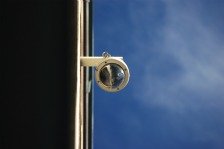Outdoor Video Surveillance - Where to Place Cameras and Types of Cameras
Outdoor video surveillance should be part of your surveillance strategy. By having visible cameras outside, you will be better able to deter criminals from attacking your house. You can also capture criminal activity before they enter your house.
You need to determine where you are going to place the cameras and the type of cameras you need for outside.
Camera Placement

Depending on your home security strategy, you will probably want to ensure that your cameras are visible. This will hopefully deter the bad guys from invading your house.
You would want to place the cameras in the front yard where people from the street would be able to see that you have cameras operating.
For your outdoor video surveillance, one option is to place your cameras aimed at a location where outsiders can enter the perimeter of your property.
Another option is to place the cameras where they are monitoring the outside entry ways into your house. This way you will be able to have surveillance of anyone who enters the house.
You can also place the cameras that both monitor the perimeter of your yard and monitor the entry ways.
Depending on what is in your yard, you also might want to monitor high value areas such as pools or fountains.
Type of cameras
When you place cameras outside, you have to deal with different issues than with cameras that are inside. The weather can be extremely hot, cold, or wet. Also, you will need to deal with different lighting conditions.
There are many different types of features that are available on cameras. Here are a few that you should consider for outdoor video surveillance.

You can get special housing to place the video cameras in. There are also housings that have heaters or blowers to help with cold temperatures.
Because you would want to have surveillance during night time, you want a camera that has capabilities to view in the dark. You need a camera that has infrared illumination capabilities.
You also might want to consider buying a camera with motion detection built-in. If you did not have this feature, you would have to monitor continuously throughout the day. This can take up a lot of video storage and you would have to figure out how to handle this. With motion detection, the camera only starts recording when motion is detected.
For your home security, you also might want to consider wireless digital cameras. These cameras can be placed anywhere, and you do not have to have the hassles of figuring out how to deal with wires and cables. These cameras can be installed much more easily.
With outdoor video surveillance, you should also consider the surveillance laws of your local area/state. For the most part, if you are monitoring areas on your property, you should be OK. It does get into a grey area if you are monitoring outside of your property. We are not lawyers, so you should check with your local laws prior to monitoring.



